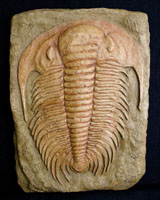Trilobites were a highly sophisticated group of organisms that were very successful during the Paleozoic Era. They are an extinct group of arthropods that primarily inhabited shallow sea-floors and reefs. All arthropods have a solid exoskeleton and jointed limbs. Living arthropods include insects, crustaceans (lobsters, crabs), centipedes, and spiders.
Trilobites were extremely advanced for their time. They were the first known animals to have the use of eyes, some very complex in derived species. The name "trilobite" refers to the "three lobes," or longitudinal body sections characteristic of all trilobites. Trilobites can also be divided along their width into three body segments known as the cephalon (head region), the thorax (mid-section), and the pygidium (tail region). They also had many legs, each equipped with a set of gills that seldom fossilized.
It is believed that the first trilobites appeared 545 million years ago at the beginning of the Cambrian Period. Trilobites became very numerous and advanced, reaching their zenith at the end of the Cambrian Period. Several major extinctions reduced the number of species until the last remaining trilobites became extinct at the end of the Permian Period, 250 million years ago. Fossilized trilobites, with their worldwide distribution and thousands of distinct genera and species have become a valuable tool in determining the ages of certain rock units.
This species, Acadoparadoxides briareus, was a giant among most other trilobite species, which were rarely longer than one inch. Acadoparadoxides inhabited shallow seas approximately 530 million years ago during the Cambrian Period. This is a replica of a fossil found in the Jbel Wawrmast Formation in the Anti-Atlas Mountains of Morocco.
From the collection of J. Stewart Hollingsworth
Acadoparadoxides briareus 
Quantity in Basket: None
Code: ART-150
Price: $135.00
Shipping Weight: 2.19 pounds
Time: Cambrian Period approximately 530 million years ago.
Location: Jbel Wawrmast Formation, Anti-Atlas Mountains, Morocco
Dimensions: 10" x 13" x 1-5/8"